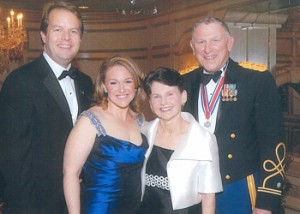Distinguished Career as JAGC Officer Began with ROTC
By Duncan O’Dwyer ’60
One of the great experiences I had while attending Lafayette was participating in ROTC. My brother and uncle were officers in the Army and Navy respectively, and it was expected that I would follow in their footsteps obtaining a commission. In 1956, ROTC was robust with about 700 cadets from the freshman and sophomore classes and about 120 from the junior and senior classes. Lafayette had branch designations for advanced ROTC. If you were a liberal arts student, you wore the Infantry Crossed Rifles; engineering students wore the Ordnance Pot and Flame. Upon graduation, your choice of branch was already determined.

Duncan O’Dwyer ’60, wearing the New York Conspicuous Service Cross, which he received from Governor George Pataki, with his wife Alice, daughter Pam McGaan, and her husband, Andy McGaan.
I was an enthusiastic participant and thoroughly enjoyed our six-week training at Ft. Meade, Maryland, after completing junior year. The following fall, I served as cadet colonel for the semester. I will always recall fondly being on the Quad with about 800 people reporting to me. I also served as captain of Scabbard and Blade Honorary Society, a highly regarded military society at Lafayette at the time.
Following graduation from Cornell Law School in 1963, having volunteered for a two-year tour of duty while at Lafayette, I reported to Ft. Benning, Georgia, for officer infantry basic course. Upon graduation, I reported to the First Infantry Division at Ft. Riley, Kansas, in December 1963. As a STRACK Division, it was always training in order to be ready for immediate deployment upon orders.
As luck would have it, I was assigned to the headquarters staff of the First Brigade and had administrative responsibility to coordinate all of the training for 22 colleges and universities from the Midwest at Ft. Riley for the ROTC cadets. We had in excess of 2,000 students training over a six-week period during the summer. I was liaison between the post and all the professors of military science at all of the colleges and universities. I did this for two years. In between I had a five-month tour of duty at Ft. Irwin, California, in the Mohave Desert, participating in desert training. What an experience!
As my period of active duty was coming to an end, the entire First Infantry Division was put on orders to go to Vietnam. Because I had less than 90 days remaining on my tour and active duty tours had not been extended by President Johnson, the Division left for San Francisco and subsequently Saigon while my wife and I along with our new baby girl headed for home.
Back in New York, I was preparing to take the New York State Bar (I had passed the Kansas Bar while at Ft. Riley), when I received notice that if I did not participate in Reserve activities, I would lose my commission. That prompted me to transfer my branch from Infantry to Judge Advocate General Corps and led to a 26-year career as a JAGC Reserve Officer, retiring in 1988 as Lt. Colonel.
I practiced law with a firm that encouraged my Reserve participation. I had a full career as a practicing attorney as well as a Reserve JAGC Officer, which led to my being certified as a military judge at the Judge Advocate Generals School in Charlottesville, Virginia, in August 1981.
Toward the end of my military career, I served as Staff Judge Advocate of the 98th Division Training, which was headquartered in Rochester, New York, over a four-year period. I reported to the commanding officer, a Two Star General. I had 19 lawyers working for me around the state. The division had 8,500 personnel. I also traveled to Bonn, Germany, and Copenhagen, Denmark, with the Army as a NATO Delegate.
O’Dwyer is managing partner with Forsyth, Howe, O’Dwyer, Kalb & Murphy, P.C.